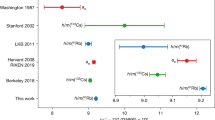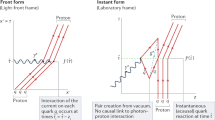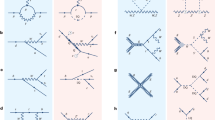Abstract
Quantum electrodynamics, despite its many successes, has left many questions unanswered. Why is electrodynamics so different from other interactions? Why do all particles have commensurate electric charges? Why is the value of the fine-structure constant what it is? Today, we have an apparently correct and essentially complete description of all of elementary particle physics in terms of a gauge theory1. If the underlying gauge group is simple2,3, all three elementary particle interactions—strong, weak, and electromagnetic—are parts of one unified theory. (The earlier attempt to synthesise all three interactions obtained both charge quantisation and baryon number violation. It was not based on a simple gauge group, nor did it incorporate conventional quantum chromodynamics.) Electromagnetism is no longer so unique. Apparent differences among the interactions reflect the pattern of spontaneous symmetry breakdown. Charge quantisation is forced on us: all fields have integer mutiples of one-third the electron's charge2,3; all observable particles have integer multiples. (We assume that colour is a truly hidden variable, that quarks are fractionally charged and never liberated. For another point of view, see ref. 4.) The fine-structure constant cannot be chosen arbitrarily. For unified theories in which the proton is unstable, we find an upper limit to its strength, α <0.04. We derive this result here and survey the context in which it arises.
This is a preview of subscription content, access via your institution
Access options
Subscribe to this journal
Receive 51 print issues and online access
$199.00 per year
only $3.90 per issue
Buy this article
- Purchase on Springer Link
- Instant access to full article PDF
Prices may be subject to local taxes which are calculated during checkout
Similar content being viewed by others
References
Gell-Mann, M., Ramond, P. & Slansky, R. Rev. Mod. Phys. 50, 721–744 (1978).
Pati, J. C. & Salam, A. Phys. Rev. D8, 1240–1251 (1973).
Georgi, H. & Glashow, S. L. Phys. Rev. Lett. 32, 438–441 (1974).
Pati, J. C. & Salam, A. Phys. Rev. D10, 275–289 (1974).
Weinberg, S. Phys. Lett. B82, 387–391 (1979).
Ellis, J., Gaillard, M. K., Nanopoulos, D. V. & Sachrajda, C. T. CERN Preprint-TH-2634 (1979).
Bouchiat, C., Iliopoulos, J. & Meyer, Ph. Phys. Lett. B38, 519–523 (1972).
Shvartsman, V.F. JETP Lett. 9, 184–186 (1969).
Steigman, G., Schramm, D.N. & Gunn, J.E. Phys. Lett. B66, 202–204 (1977).
Yang, J., Schramm, D. N., Steigman, G. & Rood, R. T. Enrico Fermi Institute Preprint 78–26.
Kobayashi, M. & Maskawa, K. Prog. Theor. Phys. 49, 652–657 (1973).
Glashow, S. L. Proc. of the LEP Summer Study, Vol. 1, 285–312 (CERN, 79-01, 1979).
Georgi, H. & Nanopoulos, D. V. Phys. Lett. B82, 392–394 (1979); Nucl. Phys. B (in the press).
Nanopoulos, D. V. Protons Are Not Forever (Harvard Preprint HUTP-78/A062, 1978).
Yoshimura, M. Phys. Rev. Lett. 41, 281–284 (1978).
Dimopoulos, S. & Susskind, L. Phys. Rev. D18, 4500–4509 (1978).
Toussaint, B., Treiman, S. B., Wilczek, F. & Zee, A. Phys. Rev. D19, 1036–1045 (1979).
Ellis, J., Gaillard, M. K. & Nanopoulos, D. V. Phys. Lett. 80 B, 360–364 (1979).
Weinberg, S. Phys. Rev. Lett. 42, 850–853 (1979).
Nanopoulos, D. V. & Weinberg, S. Harvard Preprint HUTP-79/A023 (1979).
Cox, P. & Yildiz, A. Harvard Preprint HUTP-79/A019 (1979).
Georgi, H., Quinn, H. R. & Weinberg, S. Phys. Rev. Lett. 33, 451–454 (1974).
Buras, A.J., Ellis, J., Gaillard, M.K. & Nanopoulos, D.V. Nucl. Phys. B 135, 66–92 (1978).
Reines, F. & Crouch, M. F. Phys. Rev. Lett. 32, 493–494 (1974).
Marciano, W. Rockefeller University Preprint C00-2232B-173 (1979).
Goldman, T.J. & Ross, D. A. Cal Tech Preprint 68-704 (1979).
Author information
Authors and Affiliations
Rights and permissions
About this article
Cite this article
Glashow, S., Nanopoulos, D. An estimate of the fine structure constant. Nature 281, 464–465 (1979). https://doi.org/10.1038/281464a0
Received:
Accepted:
Issue Date:
DOI: https://doi.org/10.1038/281464a0
This article is cited by
-
A refined estimate of the fine structure constant
Nature (1981)
Comments
By submitting a comment you agree to abide by our Terms and Community Guidelines. If you find something abusive or that does not comply with our terms or guidelines please flag it as inappropriate.



